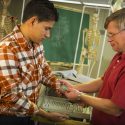Hundreds poised to present at undergrad symposium
Undergraduate scholars hailing from an array of academic disciplines will showcase their research at the 2006 Undergraduate Research Symposium, Tuesday, April 11, in the Memorial Union Great Hall.
The University of Wisconsin–Madison symposium has steadily grown in participation and now consistently attracts more than 200 presenters. This year, 214 students will take part. The event will begin with a welcome to all participants at 9:45 a.m. in the Great Hall.
“It’s important for undergraduates to participate in research,” says Virginia Sapiro, interim provost and vice chancellor for academic affairs. “Presenting at the symposium helps students gain confidence they can conduct research and teach others about their research, and the best way to learn is to teach.”
The heart of the symposium will comprise of 126 students from the Undergraduate Research Scholars Program (URS), a yearlong course that exposes first- and second-year students to academic research. URS students choose research endeavors based on interest and work closely with faculty and research staff on projects.
“URS is a wonderful opportunity for new students to engage in learning beyond the classroom,” says Svetlana Karpe, director of URS. “For some students, the research makes a difference in how they understand the learning process. Students can explore what they’re interested in and many choose to major in the area of their research.”
Bonnie Williams, a senior majoring in journalism, URS fellow and former URS student, says that participating in research as an undergraduate has inspired her to continue the research process after graduation.
“Once I completed my first research project and realized that I shed light on a topic and showed support for an idea that I personally experienced, I knew that I wanted to continue in the field of research,” says Williams.
Williams has committed three years to the URS program. Now, as a research fellow, she is responsible for the guidance of 10 students. “As a fellow, I get to expose students to other forms of research that may or may not pertain to their field,” says Williams. “It broadens students’ horizons and helps them grow and see that research is all around us. It’s a part of our past and a part of our future.”
The symposium offers participants the opportunity to present their findings to an audience of professors, faculty and peers.
“My favorite part of the symposium is the incredible grins on student and faculty faces. Both are excited about what their doing and they really convey a passion for knowledge,” says Sapiro.
Chris White, a freshman enrolled in URS, will give an oral presentation on his research, a study on markets across the United States. His work will be incorporated into a written report for the New Maxwell Street Market Commission, a group set up by the city of Chicago to examine market changes. White worked with Alfonso Morales, professor of sociology, as a faculty mentor.
White spent much of his time pulling reports and data from the stacks of the Wisconsin Historical Society.
“There’s something very entertaining about working with such old documents and finding a way to have them possibly change the future,” adds White.
Mentors play an important role in introducing students to the research process. Amir Assadi, professor of mathematics, has worked with undergraduates in interdisciplinary research for more than 12 years.
“Undergraduate research opportunities are vital in training students to learn outside the box,” says Assadi. Research can help prepare “undergraduates for graduate school, or for a research and development corporation.”
A few notable projects from the symposium will be featured at the poster session in the Capitol Rotunda on April 25. Students worked with faculty experts on the following:
- Parkinson’s and drug abuse: Math students Abby Maki and Sheshali Wanchoo compared mathematical models of neural networks between Parkinson’s disease and drug abuse. Parkinson’s disease, a progressive neurological discover is associated with the death of dopamine-producing neurons in the brain.
- Indian American political performance: Communication arts student Mona Mogahed examined a political performance piece written and enacted by Indian American artist Shyamala Moorty, which focuses on the damaging social effects of religious and political fundamentalism.
- Race, culture and identity in Argentina: History student Nadya Perez-Reyes examined how a black musical and dance form, the tango, became identified as a national symbol of white Argentine society during the 20th century.
- Heart disease and depression: Nursing students Kevin Bjork, Heather Breikreutz, and Shee Yee Chang explored the factors behind why African Americans have a higher risk for depression and heart disease. Students reviewed a clinic sample of African Americans in Dane County.

